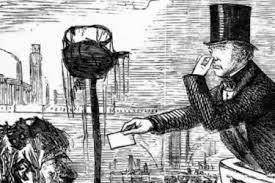London during the Industrial revolution was far from a pleasant place to live. The mass expansion of the city as people headed to the area to find work caused health problems caused by dirty water, and the factories were busily pumping out toxic waste into the air causing respiratory illnesses. This period of change in the country certainly came with many health risks, but because of this it also brought with it the solutions to the problems that were caused and an understanding of how to deal with them.
The outbreaks of cholera during the Victorian times were huge and killed large numbers of people. In fact, a famous illustration of this era depicts death as the Grim Reaper, on a boat heading down the River Thames! It was this that led to the creation of the network of sewers. These were first built in London and then other large cities quickly also had sewer systems built as the rates of water borne illnesses quickly dropped off. Nowadays many of the sewers that we use date back to this era, so they do need some care from time to time, from specialists such as this sewer pipe lining Solihull based company https://www.wilkinson-env.co.uk/sewer-repairs-drain-lining-concrete-cutting/drain-repairs/drain-repairs-solihull/

Something that plagued London for many years and long after the Industrial revolution was the poor air quality. In fact, the bad air in London, became something that it was known for. On the worst days, the London pollution in the air was so thick that it was often described as a pea souper, due to its consistency! During the 1950s, the London smog killed many people, and it was certain that something had to be done about this problem.

More recently, things have been put in place to improve the air quality in London. For example, nowadays there is a congestion charge and getting around by bicycle, on foot and of course using the network of underground trains are all heavily encouraged in the city, making the air quality a lot better than it once was. It also tends to work out cheaper to use the other modes of transport in London rather than being reliant on driving a car.


